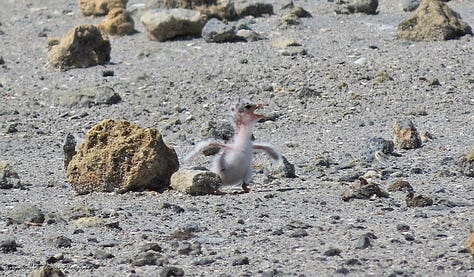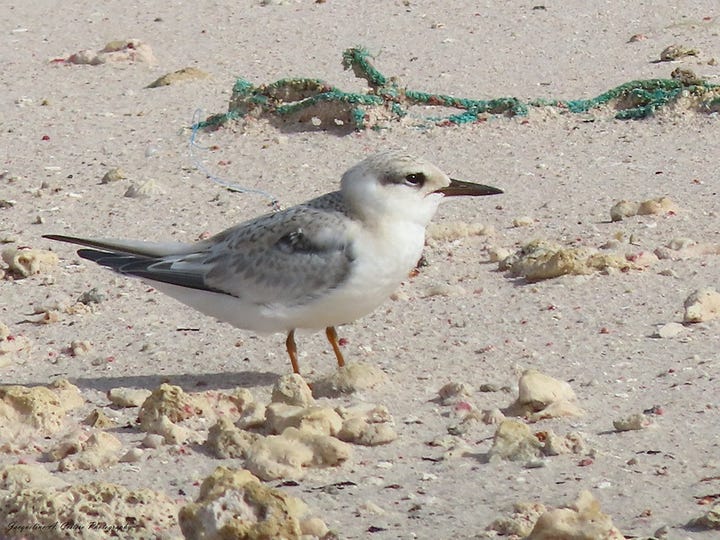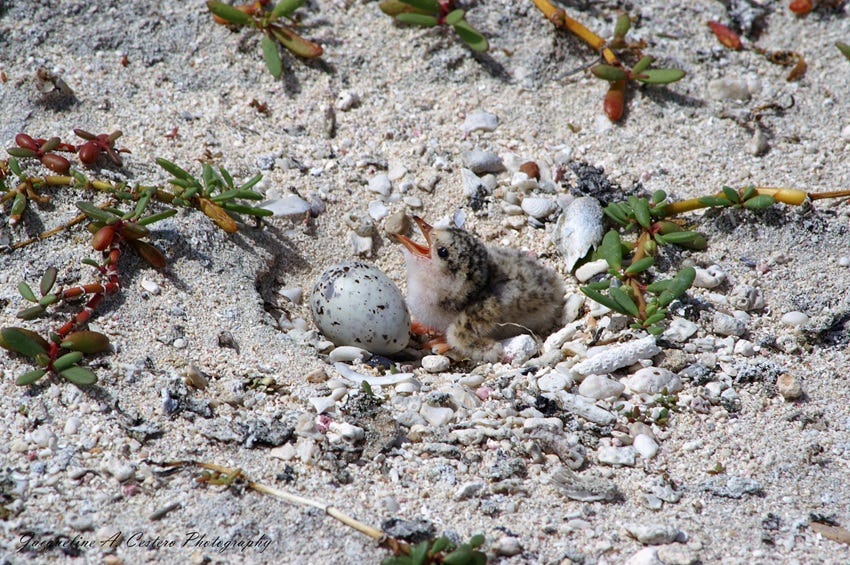Annually a little over 1% of the world’s population of Least Terns breed on Anguilla’s wetlands. This is one of the reasons that many of the island’s salt ponds have received the Important Bird Area designation from Birdlife International.
I have been lucky to spend countless hours with these birds albeit at a conservative distance so as not to interfere with their reproductive cycles.
Because we see most individuals of this species in breeding plumage, Birds of the World describes that plumage phase as follows:
“Smallest of North American terns: length 21–23 cm, wingspan 48–53 cm. In Definitive Alternate (adult breeding) plumage, black cap and loral stripe contrasting with white forehead are distinctive. Remainder of upperparts gray, underparts white, outer 2 (rarely 3–4) primaries black; striking dark-tipped yellow or orange bill. Sexes similar. Dark loral stripe considered wider in male (Olsen and Larsson 1995), but sexes more reliably distinguished by behavior.”
Although currently listed as a species of “Least Concern,” it has had its challenges:
“Once substantially reduced by collection to adorn women's hats, the Least Tern portrays a roller coaster of changes in population. Diminished by recreational, industrial, and residential development in coastal breeding areas and significantly altered hydrology at interior breeding areas since the 1950s, it is specially classified for protection in much of its North American range. No other wide-ranging North American tern has that unfortunate distinction.”
Choosing Anguilla as a breeding site has brought its own set of challenges for Least Terns.
Most birds arrive in April and congregate on salt ponds. You will often find them on the rock walls within the ponds and feeding on nearby waters. Aireal displays are frequent and a precursor to choosing a mate.
Courtship occurs over a two to three-week period and the presentation of a fish is an integral part of the dance.
“Nest Construction Process
Nest is shallow scrape in sand, soil, or pebbles, to which bits of shell, light-colored pebbles, or small bits of wood or grass stem are occasionally added after incubation has begun. Makes scrape by sitting on substrate and kicking feet backward while rotating body, using breast to form shallow depression made by feet.”
Clutch size is normally 2 to 3 but I often see just 1 egg in the Anguilla population. The egg color is as follows:
“Ground color beige to light olive brown; spots or splotches medium brown to black. Ground and spot color, as well as number, size, and distribution of spots, vary greatly, even within a clutch.”
The female performs the lion’s share of the incubation over 19 to 25 days. The male is found nearby providing protection and food for the female. I also see the adult dip in the water to provide cool shelter for eggs under extreme temperatures during the day.
Chicks peep inside the egg before hatching and emerge over two days. They weigh approximately 0.15 ounces at hatch.
“At hatching, chick is wet, down-covered, and has prominent white egg tooth, open eyes, and limited thermoregulatory abilities. Color of down and skin varies considerably within and among broods.”
After the chicks hatch, the parents brood them for 24 to 48 hours until they can independently maintain a steady body temperature.
Once hatching occurs, life changes for the tern parents. Unlike the stilts discussed previously, tern chicks are altricial.
“Altricial species are those in which the young are underdeveloped at the time of birth, but with the aid of their parents mature after birth.”
Although the birds are covered in down, they depend on their parents for food. In my observation, feedings occur approximately every fifteen to twenty minutes. The male seems to be the primary food provider. With two chicks feeding, both parents are involved. That means a lot of trips back and forth to the food source while ensuring the security of the vulnerable chicks!
Chicks are very vocal and recognize the parents as they return to provide food.





Least Tern chicks take their first flight at about 20 days.
Adults may feed juvenile birds up to eight weeks of age. They also teach them to fish for themselves. I have seen an adult dangle a fish in front of the juvenile and lure them closer to the water to encourage fishing on their own. It is a process as they say!
Least Terns reach sexual maturity between two and three years and generally live for 24 years.


In this companion reel, I share a few moments with the colony on West End Pond IBA. The nest in this video started with two eggs. Unfortunately, one egg was predated after the first two days.
Least Tern eggs and vulnerable chicks fall victim to natural predators like Laughing Gulls. They are at much higher risk from human-introduced predators such as feral cats and unleashed dogs. A feral cat colony in an abandoned hotel near this nest location killed many of the chicks in this small colony.
One benefit of colonial nesting is the ability to fend off predators with the strength of all the birds in the colony. With each adult bird weighing less than two ounces, the colony is no match for a ten-pound cat or a fifty-pound dog, let alone a pack. The video shows the force of the colony as it defends the chicks from the perceived threat of a Yellow-crowned Night Heron. The heron was trying to get close to his girlfriend on the other side of the pond!
Least Terns have faced further setbacks during the 2024 breeding season as Anguilla has experienced unusually high levels of rainfall since May. Their usual breeding sites have been underwater throughout the season and early nests were lost. Whether this is a one-off event or a new trend due to the impacts of climate change remains to be seen.
The good news is that the family in this video was able to raise its chick to a juvenile and it ultimately left with the parents for a life at sea. Perhaps one day, it will return to nest on Anguilla’s shores. There are some adorable chick moments to enjoy here!














Spectacular! Many thanks 🙏🏽
Such an interesting article Jackie: Thank you so much!